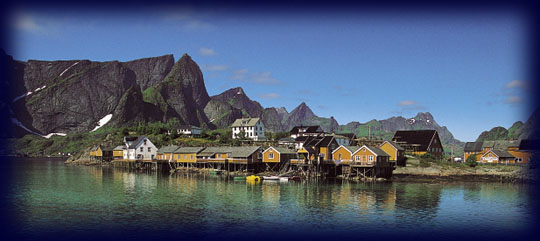SAKRISØY, LOFOTEN ISLANDS
Sakrisøy, N-8390 Reine i Lofoten
Tel. +47 76 09 21 43 - Mobile:
900 35 419
Email:sakrisoy@lofoten-info.no
- An extraordinary experience!

Welcome to Sakrisøy
Sakrisøy is Lilliput among the fishing villages of the Lofoten Islands, yet it can still offer everything that is characteristic of a true fishing village - and more.
For five generations, the Gylseth family has bought fish and done business and trade on this tiny isle, caught as it is between sea and fjord, outermost in the Lofoten Islands. Shortly after Christmas, and continuing on towards Easter, the giant Lofoten cod are still piled on to the quayside, ready to be hung on the stockfish racks that cover most of the island. Today, we supplement these traditional activities with tourism, and the sale of fresh fish during the summer. Previously, the "rorbu" cabins were an important factor in attracting visiting fishermen to stay at the fishing station. Now, they are an attraction to travellers from far and wide, who seek to experience the Lofoten Islands - and stay in overnight accommodations with the sea beneath their floorboards.
We have yet to mention the most exciting and unexpected attraction on the island. Amid fish racks and rorbu cabins, in what used to be a barn with sheep, cows and Linda the horse, we find Dagmar's Museum of Dolls and Toys, the first of its kind in Norway. Here, we find Norway's largest collection of old dolls and toys open to the public. In the loft above the museum, antiques and second-hand goods are sold, and should you so desire, you can enjoy a nice cup of coffee and some freshly made waffles there.
Did someone suggest that porcelain dolls made in France or Germany have no place in a fishing village north of the Arctic Circle? Well, don't be too sure about that. For centuries, stockfish from the Lofoten Islands has been a coveted commodity, finding its way even as far afield as Italy. The boats that set off loaded with stockfish returned with sugar, flour and other necessities, and when times were good, they might also came back with indulgencies for decoration and pure pleasure. During the last century, the parlours of the merchants of Lofoten would often be equipped with furniture made in workshops on the Continent; at social events the ladies would be adorned in the latest fashions from Paris, and porcelain dolls from far afield would lie in the beds of their children.
Today, the Lofoten Islands are less than ever to be regarded as some distant corner of the world. But whereas all kinds of exotic tongues can be perceived here during the summer, it is largely the cod alone that has chosen the Lofoten Islands as its destination during the winter. From all over the Northeast Atlantic, they swarm down towards the Vestfjorden, driven by ancient instinct.
Our advice is to do as the cod do! Come to the Lofoten Islands when the sun is once again above the horizon, the fishing boats hasten in and out of the harbours, the gulls are in high spirits and the quayside is a hive of activity. Then Lofoten is Lofoten.
We wish you welcome!
Dagmar og Michael Gylseth
How to get to Sakrisøy
Sakrisøy is situated 3 km from the well-known fishing village of Reine, in the borough of Moskenes in the western Lofotens ... where many people say that the Lofoten Islands are at their wildest and most beautiful.
Travelling by air, you arrive in Bodø where you change planes for Leknes, Lofoten - an hour's drive away from Sakrisøy. From Leknes you can catch a bus or drive a car out to Sakrisøy.
Another option is to take the train or drive your own car to Bodø and catch the car ferry over to Moskenes, only 6 km from Sakrisøy. The ferry crossing takes three and a half hours. You can also take the northbound train through Sweden to Narvik, the express passenger boat to Svolvær and the bus from there.
Or maybe you have scheduled a visit to the Lofoten Islands as part of your Coastal Steamer voyage along the coast? The liner docks in Stamsund, about a one-and-a-half hour's bus ride from Sakrisøy.
Click here to go back to the Flakstad and Moskenes Home Page